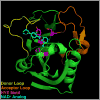New PARP targets for cancer therapy
- PMID: 24898058
- PMCID: PMC4480224
- DOI: 10.1038/nrc3748
New PARP targets for cancer therapy
Abstract
Poly(ADP-ribose) polymerases (PARPs) modify target proteins post-translationally with poly(ADP-ribose) (PAR) or mono(ADP-ribose) (MAR) using NAD(+) as substrate. The best-studied PARPs generate PAR modifications and include PARP1 and the tankyrase PARP5A, both of which are targets for cancer therapy with inhibitors in either clinical trials or preclinical development. There are 15 additional PARPs, most of which modify proteins with MAR, and their biology is less well understood. Recent data identify potentially cancer-relevant functions for these PARPs, which indicates that we need to understand more about these PARPs to effectively target them.
Figures



References
-
- Bürkle A. Poly(ADP-ribose). The most elaborate metabolite of NAD+ The FEBS journal. 2005;272:4576–4589. - PubMed
-
- Kleine H, et al. Substrate-assisted catalysis by PARP10 limits its activity to mono-ADP-ribosylation. Molecular cell. 2008;32:57–69. - PubMed
-
- Marsischky GT, Wilson BA, Collier RJ. Role of glutamic acid 988 of human poly-ADP-ribose polymerase in polymer formation. Evidence for active site similarities to the ADP-ribosylating toxins. The Journal of biological chemistry. 1995;270:3247–54. - PubMed
Publication types
MeSH terms
Substances
Grants and funding
LinkOut - more resources
Full Text Sources
Other Literature Sources
Miscellaneous

